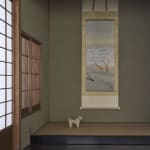Yokoyama Taikan (1868−1958)
Spring
Color on silk, hanging scroll
Yokoyama Taikan registration no. me-25
With a box signed by the artist, double boxed
Seal: Taikan
123.5 x 50.5 cm
213 x 65 cm (overall)
Further images
The style of this painting and the characteristics of its signature suggest that it might be executed around the year of 1900. In particular, the signature in the style of harigane rakkan, literally “wire signature” done in thin lines using fine-point brush, which Yokoyama Taikan is known to have used between 1900 and 1903, indicates that this is a rather rare early work of Taikan during the Meiji period, comparing to the later ones of the Taisho and Showa periods that survived in larger numbers.
Right in the foreground, a cherry blossom tree stands among the hazy air. Taikan painted the petals in gray, perhaps to depict them against the light, or to express their movements by the wind. Does this work represent the moment of nightfall, when the horizon is tinted with the madder red of the sunset and the clouds containing moist gradually fall, or the scene of sunrise, when the morning twilight sheds on the hills opposing the cherry blossom tree and early birds start to catch worms here and there? It is rather ambiguous to determine in this painting. Inspired by their teacher Okakura Tenshin’s challenge to depict air, Taikan, together with Hishida Shunso, established a technique, which disposes the conventional line drawing-concentrated style, and drips and spreads pigments on dampened silk. This innovative style, dubbed moro-tai, or hazy style, was accused for deteriorating the long-established nihonga tradition. The debate became a scandal, which depreciated the fundamental value of the newly-founded Japan Art Institute. Considering the ambitious young Taikan’s will of creating the novel nihonga, this painting shall be read as depicting the start of a new day.
Yokoyama Taikan (nihonga painter; 1868−1958)
Ibaraki-born nihonga painter. His real name is Hidemaro. Became a dicsiple of Okakura Tenshin and Hashimoto Gaho. Assisted Tenshin in the founding of Nihon bijutsuin (Japan Art Institute), and played an active role as the core member. Also appointed to a jury in Bunten (Ministry of Education Art Exhibition). Played an influential role in the modern nihonga history from Meiji to Postwar era. Designated as an Imperial Court Artist and a Person of Cultural Merit, and received the Order of Culture.
Right in the foreground, a cherry blossom tree stands among the hazy air. Taikan painted the petals in gray, perhaps to depict them against the light, or to express their movements by the wind. Does this work represent the moment of nightfall, when the horizon is tinted with the madder red of the sunset and the clouds containing moist gradually fall, or the scene of sunrise, when the morning twilight sheds on the hills opposing the cherry blossom tree and early birds start to catch worms here and there? It is rather ambiguous to determine in this painting. Inspired by their teacher Okakura Tenshin’s challenge to depict air, Taikan, together with Hishida Shunso, established a technique, which disposes the conventional line drawing-concentrated style, and drips and spreads pigments on dampened silk. This innovative style, dubbed moro-tai, or hazy style, was accused for deteriorating the long-established nihonga tradition. The debate became a scandal, which depreciated the fundamental value of the newly-founded Japan Art Institute. Considering the ambitious young Taikan’s will of creating the novel nihonga, this painting shall be read as depicting the start of a new day.
Yokoyama Taikan (nihonga painter; 1868−1958)
Ibaraki-born nihonga painter. His real name is Hidemaro. Became a dicsiple of Okakura Tenshin and Hashimoto Gaho. Assisted Tenshin in the founding of Nihon bijutsuin (Japan Art Institute), and played an active role as the core member. Also appointed to a jury in Bunten (Ministry of Education Art Exhibition). Played an influential role in the modern nihonga history from Meiji to Postwar era. Designated as an Imperial Court Artist and a Person of Cultural Merit, and received the Order of Culture.









